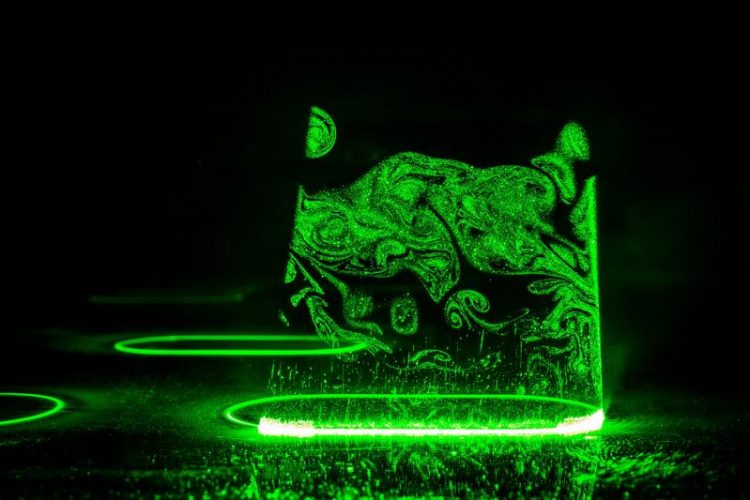CeGlaFlex project: wafer-thin, unbreakable and flexible ceramic and glass

Structuring process by direct ablation with ultrashort pulse laser radiation. © Fraunhofer ILT, Aachen, Germany / Volker Lannert.
Mobile electronics, regardless of whether it is a cellular phone, tablet or blood pressure monitor, rely on the quality of their touch-screen displays. In keeping with the trend of individually shaped smart devices, they should be not only scratchproof, unbreakable and chemically stable, but also easy to mold.
However, this presents a dilemma for manufacturers. “Hardened glass does not possess the required design flexibility, while malleable plastic is easily scratched,” explains Christian Kalupka, ultrafast laser expert at Fraunhofer ILT. “Transparent ceramics offer an alternative. Although they have the desired properties, they are not yet available in the desired sizes and lack appropriate processing methods.”
An eye on the complete process chain
This was reason enough for the Fraunhofer-Gesellschaft to initiate the internal CeGlaFlex research project (process chain for malleable ceramic and glass-based switching and display elements) in March 2017. It involves market-oriented strategic pre-competitive research (MaVo) to develop techniques and process chains. Its objectives are to:
- manufacture thin, and as a result malleable and transparent, ceramics and display laminates.
- process transparent ceramics and thin glass compounds, which can be spatially reshaped without damaging the material’s functions.
- produce integrated switching and display elements on malleable substrates made of ceramic-glass compounds.
The MaVo project is implementing the complete process chain at five Fraunhofer Institutes. The Fraunhofer Institute for Ceramic Technologies and Systems IKTS in Dresden is developing thin, highly transparent ceramics.
In Aachen, the Fraunhofer Institute for Production Technology IPT is working on processes for the precise mechanical finish (grinding, polishing) of surfaces and edges of transparent, thin ceramics and glass, while the neighboring Fraunhofer Institute for Laser Technology ILT focuses on customized laser processing (polishing, structuring, separating).
In Halle (near Leipzig), the Fraunhofer Institute for Microstructure of Materials and Systems IMWS is developing material testing methods that are important for assessing component quality. Final implementation of the process takes place at the Fraunhofer Institute for Organic Electronics, Electron Beam and Plasma Technology FEP in Dresden, which builds marketable demonstrators.
Huge market potential
Kalupka is optimistic about the project’s future. “Thanks to the technologies developed in the joint project, wafer-thin ceramic will be used to manufacture flexible and unbreakable displays for portable electronics of the future. I’m confident that they will play a major role in the success of many smart mobile devices.”
Media Contact
All latest news from the category: Process Engineering
This special field revolves around processes for modifying material properties (milling, cooling), composition (filtration, distillation) and type (oxidation, hydration).
Valuable information is available on a broad range of technologies including material separation, laser processes, measuring techniques and robot engineering in addition to testing methods and coating and materials analysis processes.
Newest articles

Innovative 3D printed scaffolds offer new hope for bone healing
Researchers at the Institute for Bioengineering of Catalonia have developed novel 3D printed PLA-CaP scaffolds that promote blood vessel formation, ensuring better healing and regeneration of bone tissue. Bone is…

The surprising role of gut infection in Alzheimer’s disease
ASU- and Banner Alzheimer’s Institute-led study implicates link between a common virus and the disease, which travels from the gut to the brain and may be a target for antiviral…

Molecular gardening: New enzymes discovered for protein modification pruning
How deubiquitinases USP53 and USP54 cleave long polyubiquitin chains and how the former is linked to liver disease in children. Deubiquitinases (DUBs) are enzymes used by cells to trim protein…



